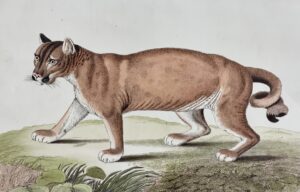
James Wilson, Illustrations of Zoology, pl.1, 1846, JY 953, Centre for Research Collections
When we first learned of a live puma once part of the Natural History Museum’s collection and roamed within Old College at night, sparked our curiosity with numerous questions:
How it was taken cared for? Where did it come from? What did it look like? Who brought it here? Where did it goes…
Although our investigations shed light on some mysteries, others were swallowed by the shadows of time. Yet, it was clear we were not only chasing factual answers, but also trying to perceive the world through the puma’s eyes: an animal uprooted from São Paulo, thrust into Edinburgh and the alien environment of the Old College, a place far from a natural habitat.[1]
Confronted with a large amount of histories in our brief, our challenge was creatively presenting them within the limited scope of our exhibition. Drawing inspiration from the “Foucault Effect” in Museum Studies, we took the notion of “effective history,” which acknowledges the fragmented and non-linear nature of historical account.[2] This approach revealed the narratives of animals or people that history often neglects.

Yoko Ono: Odyssey of a Cockroach, 2003 18 Wooster Street, Deitch Projects (online)
This switch of perspective can serve as a window of the ‘othering’ that happened inside this building, which can mirror YOKO ONO’s exhibition Odyssey Of A Cockroach at Deitch Project in 2003. This exhibition dramatically presented the urban existence from the view of cockroaches, through exaggerating trash, shoes, metal wire nets and so on, reflecting on the fact that there are more than human beings who live in architecture for their survival, thereby critiquing human arrogance and a challenge to anthropocentric narratives.[3]
Reflecting on the architectural history of the Old College, where a puma from another continent once inhabited the building as a collection; where natural history scholars have studied attempting to include the platypus in existing catalogues when it might just be a brand new species; where there were female scholars like the Edinburgh Seven attempting to gain medical accreditation, and where the university building serves the Boys’ Club. By employing counter-narrative, stories from those who have been historically marginalised are presented. we can resist the dominant discourse and inspire a more critical look at our environment.
By advocating for such perspectives, we hope to create a more inclusive and decentralised interpretation of what the Talbot Rice Art Museum looks like today, acknowledging its evolutionary tendencies that have not always been positive and its diverse history.
[1] James Wilson, Illustrations of Zoology: Being Representations of New, Rare, or Remarkable Subjects of the Animal Kingdom, Drawn and Coloured after Nature, with Historical and Descriptive Details. (Edinburgh: W. Blackwood, T. Cadell, 1831), 66.
[2] Michel Foucault, Archaeology of Knowledge, 2nd ed. (London: Routledge, 2002), 5–6, https://doi.org/10.4324/9780203604168.
[3] ‘Yoko Ono: Odyssey of a Cockroach’, accessed 28 April 2024, https://www.deitch.com/archive/deitch-projects/exhibitions/odyssey-of-a-cockroach.

Leave a Reply